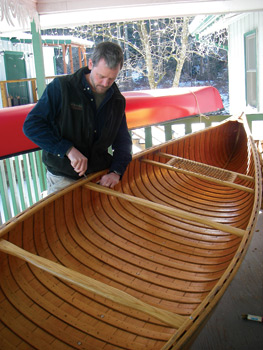
Lec Hobbs must love boats. Since coming onboard at Headwaters Outfitters 12 years ago, he has risen through the ranks to become the adventure company's sales-and-marketing director, but his passions swell out in the company workshop, where he repairs, builds and refurbishes canoes, kayaks and such. With an eye to restoring both beauty and function, Hobbs will tighten loose seats, replace rotten gunnels and hone a finish. One of his current projects is repairing a vintage vessel — a 1989 Mad River Winooski — which he'll be blogging about as he does the job. (If, like me, you didn't know, Mad River's a well-known boat-making company based in Vermont, and Winooski refers to a river that feeds Lake Champlain.)
He'll also use the work as a teaching tool, in a series of Sunday workshops geared to show boat owners how to fix their own boats (see the sidebar for details).
Xpress caught Hobbs between projects and quizzed him about his art.
Mountain Xpress: What drew you to canoe fixing?
Lec Hobbs: I started working on them when I started at Headwaters Outfitters. My job was keeping our fleet of 40 boats in good shape. Anytime something broke, it was my job to fix it.
What is it about canoes that you find interesting?
Canoes can be almost a work of art. It's such a simple craft with an incredibly long history. Outside of only a few tweaks in design, it's the same boat it was 500 years ago. When I can go out in the boat shop for about an hour and be present with the boat, it's really relaxing to me.
Can you still remember the first canoe you pounded back into shape?
The first one I did was actually brought in by a customer who wanted to see if someone could fix it. It had old wooden trim that was rotting and blown-out seats that I replaced. I brought it back to life.
What are you working on now?
A 1989 Mad River Winooski that we'll sell for $1,200 when I'm done; new, it would have been $2,000 to $2,500. But they don't make that model anymore. We'll be working on this one in our upcoming canoe-repair clinics.
Would you have a favorite saying that would help folks understand why this boat-fixing business is worthwhile?
My favorite is from Wind in the Willows: "There is nothing, absolutely nothing, half so much worth doing as simply messing about in boats." In fact, I used to have a T-shirt with this quote on it.
What's the hardest part about repairing canoes?
Mainly, finding out how to do stuff. I've had to figure it out on my own. I've learned that any boat that stays out in the sun gets damage to the finish; a lot of rubbing goes into getting that finish back.
Is there a certain satisfaction you get after you've finished a canoe?
Yes, I really feel different out there in a boat I've fixed up.
How much time do you spend working on your canoes?
I probably spend a day a week or a day every two weeks. My ulterior motive to doing these clinics is getting out there with the boats.
[Jonathan Poston is an outdoor enthusiast and freelance writer who lives in Asheville.]



This brings me fond memories of watching Camp Mondamin and Green Cove’s carpenter, Gil as he worked on boats for most of the Winter.
The brother/sister camps own several Old Town canoes, which mostly stem from the 20’s, I think. Many a camper learned the J stroke in these worn, but well repaired crafts, and a handful of kids went on to be become Olympic athletes.
You have to love a heritage that traces it’s lines through boats.
I love boats too but I don’t love wood because it’s really a bit nuts to put a lot of time into building stuff that can be eaten by bacteria and fungus unless kept dry. I like fiberglass and aluminum far better and steel too at least in fresh water. I also usually like motor, row and sailboats better than canoes and kayaks, but lakes big enough to use them are about an hour away. I find that at about 1/2 to 1 ton, motorboats use too much gas and it’s better to switch to sail, but that motors, even dirty 2 stroke motors, are still irreplaceable in the 300lb to 1000 lb range.